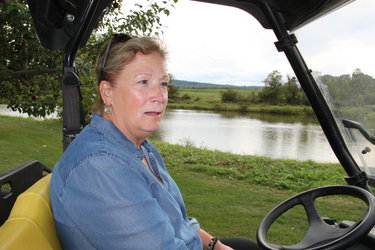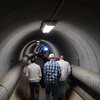Residents say Dunnsville Road solar array would ruin view of Helderbergs
GUILDERLAND — “I don’t think anybody opposes green energy, but it can’t be in your face, especially a project that big,” said Donna Abbruzzese at her home on Dunnsville Road.
She was referring to the five-megawatt solar array proposed for a 61-acre field that slopes upward beside Orchard Creek, the golf course owned by her husband, John Abbruzzese, and his brothers.
Donna Abbruzzese said the golf course, designed by Altamont native Paul Cowley, was situated to maximize the view of the Helderberg escarpment.
This would be the largest solar array in town, with panels occupying about half of the site.
The three other arrays in Guilderland are all much further from roads. On Becker Road, a 2.9-megawatt facility is located 1,000 feet off the road and stirred no controversy; it offsets the Guilderland school district’s energy bills. Two solar arrays on properties next to one another on Miller Road and Western Turnpike, each 2.7 megawatts, are about 800 to 1,000 feet off the road.
The Dunnsville Road proposal will need to be referred to the village of Altamont, town planner Kenneth Kovalchik confirmed this week, noting that the town won’t make the referral until the applicant has updated the plans to incorporate requests made by the planning board on Sept. 11. “The Town would like the Village to review an accurate depiction of the project,” Kovalchik wrote in an email to The Enterprise.
Projects that are within 1,200 feet of the village boundary or within 1,200 feet of the village’s current or future water system must be referred for a recommendation. It would take a supermajority vote of the Guilderland Planning Board to overturn Altamont’s recommendation.
In September 2016, the town considered an application from U. S. Solar Solutions for a solar farm off Route 156 above the village of Altamont, but that application was withdrawn after Altamont’s village board voted unanimously to recommend that Guilderland’s zoning board disapprove it.
This summer, state legislation was passed requiring 100 percent carbon-free electricity by 2040 and economy-wide, net-zero carbon emissions by 2050.
The Dunnsville Road array would be operated by Helios Energy New York 13, LLC, and built on land at 6604 Dunnsville Rd., owned by Joseph Muia.
The array would be straight ahead of and visible from the golf course’s wedding venue. From the course’s back nine holes, “you’d be looking at it more often than not,” Abbruzzese said.
“There are places where you could put some plantings and not see it, but any places where it rises up, it’s on a hill, so what could you put there?” she asked.
Other neighbors have commented that it would be too close to Dunnsville Road. The solar panels are proposed to start 50 feet from the road.
Barbara Murphy, whose home is built on a knoll directly across Dunnsville Road from the proposed array, told the planning board during a public hearing on Sept. 11 that her view would be impossible to screen with landscaping, unless the developer put in 150-foot trees.
The home she built a year ago is on land she bought from Joseph Muia, an angry neighbor told the board, which was confirmed through county records. Muia owns the land where the array would be built.
Muia could not be reached for comment.
Murphy asked the board if the solar company, Helios, would be offering buyouts. “I want out now. There’s no way anybody will buy my house.”
Her future view, Murphy said, will be of “a junkyard.”
Helios could not be reached for comment.
Planning board Chairman Stephen Feeney told the applicant’s engineer, Peter Yetto of Ingalls and Associates, that the renderings he had submitted at the board’s request to show how the view would be affected by the array were inadequate; they did not use photos of the actual landscapes.
Feeney was surprised, he said, that Yetto had not gone out to take photos from the neighbors’ perspectives and then shown, with “before” and “after” photos, what the effect of the array would be and how it could be mitigated.
“I would encourage you to reach out to them,” Feeney said of the neighbors.
Yetto said of his client, “They’re not opposed to some vegetation, but I don’t think they want to put 35-foot trees in.”
Muia stood and said he would have his engineer talk to the neighbors and that he would “insist that proper plantings are made.” About a dozen solar companies had approached him before, Muia said, and Helios seemed “the most responsible.”
Donna Abbruzzese told The Enterprise she was out on the golf course recently, taking photos of various perspectives to present to the planning board. A golfer who comes from Virginia once a year asked her what she was doing, and she explained about the proposed array.
He told her, she said, that if it is built, that will be the end of his annual visits. “That isn’t the view that I want to see,” he said.
Donna’s husband, John Abbruzzese, said he is considering proposing a solar array on property the couple owns. Pointing up the hill in back of the family’s home — which itself is on a hill above the roadway — he said, “You’ll never see it anywhere, except from a plane.”
More concerns
James Drzymala of 6597 Dunnsville Rd. said that living next door to a “utility-scale solar facility” had not been his idea when he bought his house.
He asked the board a series of questions about noise, glare, articulating panels, and construction sequencing plans — none of which members could immediately answer. He also determined that none of the planning board members had visited Guilderland’s other arrays.
Ultimately, Feeney said the applicant would need to address the issues raised by Drzymala.
Drzymala said he had been told at an earlier meeting that solar panels are not reflective, which had prompted him to do some research. He asked the board if any members had ever seen a solar panel in operation from five stories up.
No one had.
He showed the board members a photo on his laptop of a utility-grade solar array, with articulating panels, as seen from five stories up, which he said was taken at General Electric in Schenectady.
Board member Tom Robert said, “I assume they’re different panels.” Drzymala said, “That’s a good question, but we don’t know that.”
A board member said one of the solar panels was white, and Drzymala said that was glare. Drzymala showed it to Yetto and asked him for comment. Yetto responded that he would provide a glare analysis.
“We do them for airports, because the FAA (Federal Aviation Administration) requires us to do one if they’re close to an airport. And they come back always, ‘No concern at all,’” Yetto said.
Feeney said the board would have an independent, town-designated engineer review the glare analysis.
Drzymala asked if the panels, which will be articulating, and follow the sun, would cause glare and blind spots on Dunnsville Road. He suggested that the state’s Department of Transportation should review the effect on its state road.
Drzymala also asked about noise. He said that at the last planning board meeting he was “almost laughed at” for asking about that and was told solar panels don’t make noise. But, he said, transformers make noise, and so do articulating motors. “How much noise will these all make when they’re all articulating?” he asked.
Feeney said he would ask Ingalls to address that.
Drzymala also asked about lay-down and sequencing. He said that 3,000 to 4,000 panels are needed per megawatt and estimated there might be 20,000 panels and 15,000 posts. He asked what the plan was for off-loading these items from trucks and bringing them in while minimizing disturbance of the property. An earlier plan had shown a small lay-down area, he said, but he did not see any in the most recent plan.
Kovalchik said materials would arrive in a truckload at a time.
Drzymala asked the board to confirm that the construction would be sequenced, and next asked about the visibility of the switchyard. He said, “In a solar field, the switchyard is mounted on telephone poles.”
Feeney said he did not know that. Drzymala asked if he or other board members had been to see any of the solar fields in Guilderland and they said they had not.
Drzymala asked why the board members were questioning him, if none of them had seen a solar field in operation.
“I didn’t question you. I don’t know why you have such an attitude toward me,” said Robert.
Drzymala also asked for a representation of “the utility-scale switchyard from my house.”
“The only noise you’ll hear is the inverter,” Yetto said. “The decibel range is the same as a refrigerator when you’re standing next to it.”
Yetto also said that the amount of disturbance of the field would be limited as much as possible. “You will have some dragging,” he said.
The solar panels will be 10 feet tall at maximum tilt, the board heard, and the entire array will be surrounded by 7-foot-tall fencing. Feeney said vinyl fencing would be jarring with the landscape and would also prevent animal migration. “No one wants to look at a long blank wall of vinyl fencing,” he said.
Feeney suggested “more farm-style fencing” that would still allow “small mammals” through, while stopping deer from entering.
“The plantings are inadequate. We’re asking for much more,” Feeney told Yetto.
What’s next?
Feeney said the planning board would likely have one more meeting and then craft an advisory opinion to the zoning board, which is taking the lead.
Guilderland’s zoning code says major solar arrays will require, among other things: “A minimum twenty-five-foot perimeter buffer, consisting of natural and undisturbed vegetation … provided around all mechanical equipment and solar panel arrays to provide screening to adjacent properties and to minimize glare on adjacent properties and roadways.
The code also specifies, “Solar panels shall be placed and arranged such that reflected solar radiation or glare shall not be directed onto adjacent buildings, properties or roadways.”
A 2005 study posted on the town website called “Rural Guilderland: Open Space and Farmland Protection Plan” calls for recognizing the importance of the edges of the village, where it meets with rural Guilderland, and collaborating with the village to define development and greenbelt areas. It also calls for “protection of scenic, wooded hills and ridges from significant development.”
The plan states, “Traveling through rural Guilderland along scenic roads provides a pleasant experience and opportunity to view the area’s wonderful vistas, farmland, open space, and history … Slowly, dramatic views, unfolding along rolling hills are replaced with driveways, new homes, and the loss of rural character. However, there are opportunities to grow and change while maintaining or even enhancing those qualities that make the town special.”
Currently, the array is proposed to start 50 feet from Dunnsville Road. The minimum setback in a residential area would be 100 feet, but in an agricultural zone is 50. Utility poles to connect the array to power would be added in that 50-foot space, and the planning board is requesting that the applicant place landscaping between the road and the poles.


